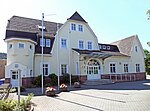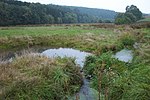Cölbe station
1852 establishments in the Grand Duchy of HesseBuildings and structures in Marburg-BiedenkopfRailway stations in Germany opened in 1852Railway stations in Hesse

Cölbe station is a junction station on the Main-Weser Railway in the town of Cölbe in the German state of Hesse. Here the Upper Lahn Valley Railway (German: Obere Lahntalbahn) to Erndtebrück via Biedenkopf and Bad Laasphe and the Burgwald Railway to Frankenberg (Eder) via Wetter and Münchhausen branch off the main line. It has four platform tracks and a passing loop. The station is classified by Deutsche Bahn (DB) as a category 5 station. The Baroque Revival station is heritage-listed under the Hessian Heritage Act.
Excerpt from the Wikipedia article Cölbe station (License: CC BY-SA 3.0, Authors, Images).Cölbe station
Kasseler Straße,
Geographical coordinates (GPS) Address External links Nearby Places Show on map
Geographical coordinates (GPS)
| Latitude | Longitude |
|---|---|
| N 50.848333333333 ° | E 8.7877777777778 ° |
Address
Cölbe
Kasseler Straße
35091 , Cölbe (Cölbe)
Hesse, Germany
Open on Google Maps











